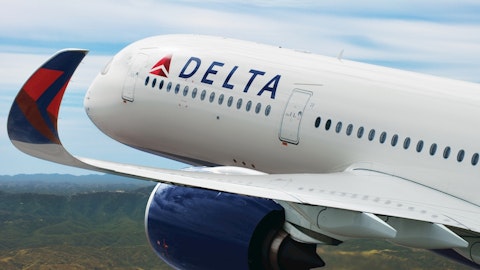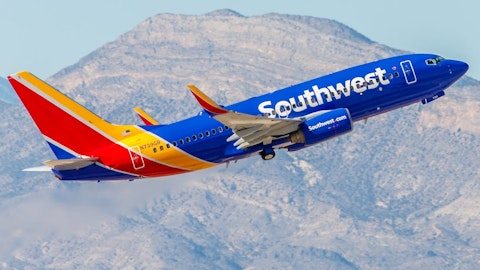Alaska Air Group, Inc. (NYSE:ALK) Q4 2022 Earnings Call Transcript January 26, 2023
Operator: Good morning, ladies and gentlemen, and welcome to the Alaska Air Group 2022 Fourth Quarter Earnings Call. . I would now like to turn the call over to Alaska Air Group’s Vice President of Finance, Emily Halverson.
Emily Halverson: Thank you, operator, and good morning. Thank you for joining us for our fourth quarter 2022 earnings call. This morning, we issued our earnings release, which is available at investor.alaskaair.com. On today’s call, you’ll hear updates from Ben, Andrew and Shane. Several others of our management team are also on the line to answer your questions during the Q&A portion of the call. This morning, Air Group reported fourth quarter GAAP net income of $22 million. Excluding special items and mark-to-market fuel hedge adjustments, Air Group reported adjusted net income of $118 million. As a reminder, our comments today will include forward-looking statements about future performance, which may differ materially from our actual results.
Information on risk factors that could affect our business can be found within our SEC filings. We will also refer to certain non-GAAP financial measures such as adjusted earnings and unit costs, excluding fuel. And as usual, we have provided a reconciliation between the most directly comparable GAAP and non-GAAP measures in today’s earnings release. Over to you, Ben.
Benito Minicucci: Thanks, Emily, and good morning, everyone. Despite another volatile year, we closed out 2022 with solid results. With our continued focus and the incredible dedication of our employees, we are well positioned to build on this success as we move into 2023 and beyond. This year, we generated full year revenue 10% above 2019 levels, doing so on 9% less capacity. Our 7.6% full year adjusted pretax margin led the industry, proving that our business model is resilient. Air Group’s pretax margins have now ranked #1 in the industry for 11 of the last 13 years. Additionally, our employees earned the largest performance bonus payout in our company’s history on average, adding 10.5% on top of our employee salaries or nearly 6 weeks’ worth of pay.
Our people did a fantastic job delivering care. I want to thank all of them for the work they do to ensure Air Group outperforms even during turbulent times. Earlier this year, we identified 3 key priorities to strengthen our competitive advantage and prepare for future growth. Our teams delivered on each of these priorities, including: one, completing our labor deals. We signed 5 labor contracts in 2022, all of which include significant improvements for our people and creates stability and clarity for our company and employees. With these in place, we are well positioned to fully focus on our future; two, fortifying our operational reliability. Despite challenges throughout the year, we finished 2022 with one of the industry’s best completion and on-time performance rates.
Operational Integrity is the foundation of a healthy airline, and we remain focused on balancing our growth aspirations with consistent delivery of the operational excellence Alaska is known for; and three, executing our single fleet transitions at both Alaska and Horizon. On January 8, we flew our last A320 revenue service flight, and today marks the final Q400 flight leaving only 10 A321s in the fleet through year-end. We have retired over 60 aircraft in the last few months, paving the way to more cost-efficient and productive operations in both our regional and mainline business. As we take off 2023, we’re taking with us many lessons learned. We closed out a solid year, and we are committed to make 2023 even better. Our leadership team has a clear set of strategic initiatives that will support our growth aspirations, expand margins and improve operational excellence.
For the full year, we expect to achieve adjusted pretax margins of between 9% and 12%. This morning, we introduced an earnings guide of $5.50 to $7.50 per share, which implies restoration to 2019 EPS levels at the midpoint. Delivering on these targets will be challenging and will require us to leverage our competitive strengths. Undoubtedly, there have been structural shifts within the industry, but history has proven time and again that cost discipline and a strong balance sheet are required to win in the airline business. This is the heart of Air Group’s DNA, and we continue to believe low cost and high productivity matter and that pursuing both benefits all stakeholders. Productivity is not where it used to be in this post-pandemic era, and it can be debated what is structural and what is temporary, but our leadership team is dedicated to driving down unit cost in 2023 as we restore flying and begin to close the productivity gap.
This strategy is largely enabled by our single fleet transition and the upgauge benefits that come with our new MAX fleet. Two critical factors to successful capacity growth in 2023 will continue to be staffing and aircraft availability. We had success in hiring nearly 8,000 people in 2022, and are confident in our plans to hire 3,500 more in 2023. And as it relates to aircraft, we remain in close communication with Boeing and have a high degree of confidence in our fleet planning assumptions as well. Having factored in the appropriate buffer in both these areas, we are confident in our 2023 plans to grow 8% to 10% versus prior year, so long as demand and the economic environment continue to support it. Lastly, the revenue road map we outlined at our March Investor Day will provide valuable contributions in 2023 and continue to build to our $400 million target.
Through focus on cost discipline and growing revenue opportunities, we have a tangible path to expand margins, and our team is excited to deliver on these in 2023. To wrap up, our goal throughout the pandemic has been to emerge a stronger, more competitive airline and the steps we’ve taken to date ensure we’re on that path. We have the people, the resources, the knowledge, and the discipline to drive performance. I am proud of the results we achieved in 2022, but even more so, I’m looking forward to the opportunities ahead of us as we deliver on our financial and strategic initiatives in 2023 and beyond. And with that, I’ll turn it over to Andrew.
Andrew Harrison: Thanks, Ben, and good morning, everyone. My comments today will focus on our fourth quarter and full year results, along with first quarter guidance. Fourth quarter revenues totaled $2.5 billion. That’s up 11.3% versus the fourth quarter of 2019, notwithstanding our capacity was down nearly 10%. These strong results included the impact of severe winter conditions that we experienced over the peak holiday travel period in December. The storm reduced revenue by approximately $45 million. Notwithstanding this, we achieved unit revenue increases of 23% for the quarter with robust loads, which exceeded 2019 levels and came in at 85.5%. More impressively, as Ben mentioned, our full year revenues came in at $9.6 billion, and that’s up 10% versus 2019 on 9% less capacity.
This resulted in industry-leading full year unit revenues, which were up 21% versus 2019, capping off a strong year of outperformance and demonstrating the leverage of our commercial initiatives, power of our network and a constructive pricing environment. Turning to product and loyalty. As has been the case all year, we continued to benefit from strong demand in our premium products. First class was up 19% and premium class up 14% versus the fourth quarter of 2019, with paid load factors up 6 points and 2 points, respectively. As we reflect on the full year of 2022, we were able to drive an increase in premium revenues of nearly $0.5 billion or 20% above 2019. Our loyalty program has also been significant revenue driver given our renewed credit card deal with Bank of America.

Photo by Stefan Fluck on Unsplash
Cash remuneration from the bank was up 42% versus the fourth quarter of ’19 and 39% for the full year. As a reminder, product and loyalty represented roughly half of our $400 million commercial initiatives, and we expect to achieve product and loyalty’s full run rate in 2023. Regarding network and alliances, we are encouraged by the results we’ve seen through our partnerships in oneworld. Through increased opportunities that we simply did not have before the pandemic, including joint contracting with American and working with MX GBT. We have meaningfully improved our corporate share gap and continue to experience higher traffic volumes facilitated by our alliance partnerships. And we are stepping up our airline partners selling capability in 2023, which will help us offering full partner inventory for 10 global carriers on alaskaair.com by year-end.
These partners include American Airlines, IAG, Japan Airlines, Qatar and Qantas, an expanded global network that we can sell and market as our own is compelling for our guests, and we expect our airline partner revenue to reach 8% to 10% of total Air Group revenues by 2025. Turning to corporate travel. We experienced a softening in bookings during the fourth quarter from those in the late summer peaks, exiting 2022 at approximately 75% recovered on a volume basis and 85% recovered on a revenue basis. West Coast business remains less recovered, which is not surprising given the significant workforce reductions happening across large technology companies located up and down the coast, where we primarily operate. Despite the choppiness we’ve seen in this segment, business.
Travel has trended in a positive direction in the last few weeks. While we don’t expect continued recovery to be linear, over time, we do still expect to fully restore our business revenue based on our improved opportunity set. Looking ahead to guidance for the first quarter. We expect total revenue to be up 29% to 32% year-over-year on capacity that is up 11% to 14% as we lap weak comps when Omicron reached its peak in the first quarter of ’22. Q1 is always our weakest quarter of the year, but leisure travel remains healthy and yields are holding steady. For the full year, we expect revenue to be up 8% to 10% on flat unit revenue. Our 8% to 10% growth in 2023 will continue to focus on deepening the connections of our network while growing the Pacific Northwest and restoring California.
Approximately 2/3 of our growth will be focused in the Pacific Northwest and 1/3 in California and will not be overly dilutive to our yields as much of it will be added to our strongest markets where demand exceeded supply in 2022. Importantly, 85% of growth comes from increased gauge and stage. This is the most efficient capacity growth of any year that I can recall at Alaska Airlines. In closing, my team and I are squarely focused on 2022 as our baseline year, which represented industry-leading unit revenue and profitability. And from that base, we look forward to building an even stronger result for 2023. The economics of our renewed credit card will continue to build this year. Our alliances and partnerships are set to gain further momentum as we improve our corporate share and international travel continues to unlock.
Our premium seat mix and upgauging opportunities will also grow as we take 37 MAX deliveries where 22% of seats are premium. This combination drives further unit revenue momentum that we believe will be a differentiator for us going forward. I’m excited for what our commercial team is set to deliver in 2023. And with that, I’ll pass it over to Shane.
Shane Tackett: Thanks, Andrew, and good morning, everyone. As you heard from Ben, our full year 7.6% adjusted pretax margin led the industry and is a great result for us given how the year started and the challenges we experienced rescaling our company in the face of incredible demand for travel. We are especially proud that all of our people will receive significant performance-based bonuses in February given their achievements this year. We are looking forward to further building towards our long-term financial goals in 2023 by remaining focused on running a reliable operation, driving unit cost and productivity improvements and delivering on our commercial road map. Turning to Q4 results and an update on our balance sheet.
We ended the year with debt to cap of 49%, within our target range of 40% to 50% and still among the strongest in the industry. Debt payments during the fourth quarter were approximately $50 million. For full year 2023, debt repayments are modest, totaling approximately $280 million with $100 million in the first quarter. Cash flow from operations totaled $1.4 billion for full year 2022 and total liquidity inclusive of on-hand cash and undrawn lines of credit ended the year at $2.8 billion, a great result, given that we continue to pay cash for our CapEx in 2022, which was one of the highest CapEx years in our history. In addition to top of industry margins and our balance sheet strength, our trailing 12-month return on invested capital reached 9% in 2022, above our cost of capital and approaching our long-term target range.
Our balance sheet strength, our cash position and our margin and return on capital results allowed us to take 2 other important steps towards the end of 2022. First, we announced in December our plan to restart share repurchases in the first quarter of 2023, initially focused on offsetting dilution. And second, we secured an expanded order book with Boeing now having firm and option aircraft positions through the rest of this decade, given overall aircraft and engine demand and ongoing supply chain challenges, having access to positions for the next 7-plus years will, we believe, prove to be beneficial strategically as it provides us maximum fleet flexibility on great terms. Turning to costs. In Q4, CASMex increased 24% versus 2019, approximately 1 point above our guide driven entirely by lost capacity and incremental costs as a result of the severe winter weather in November and December.
Absent this impact, our Q4 CASMex would have slightly beat our guide. Our full year CASMex in capacity ended the year within our guided ranges at up 20% and down 9%, respectively, versus 2019. And as a reminder, we do continue to include the cost of our performance-based bonus and incentive pay programs in our unit costs. For the full year, this represented approximately 2 points of unit cost pressure versus 2019 and was materially more impactful on our unit costs than other airlines. Our beliefs about what will drive long-term success and value in the airline industry remain largely intact and consistent with what we believed pre-pandemic. We firmly believe a strong balance sheet and low relative costs will be the ultimate drivers of business stability and success.
We remain focused on and confident in both of these areas. Our balance sheet is strong and based on 2023 guides, Alaska is positioned to achieve the best unit cost result within the industry this year, helping us maintain or improve our pre-pandemic relative cost position. Looking ahead to 2023, our current schedule has us returning to pre-pandemic levels of capacity during the first half of the year. Maintaining operational safety and reliability remains our top priority, and we will have continued modest cost headwinds as we complete the transition training related to our fleet transitions. However, we are planning for solid improvements to our overall fleet utilization and levels of productivity during 2023, and are focused on reducing unit costs on a year-over-year basis.
For the first quarter, we expect capacity to be up 11% to 14% with CASMex down 0% to 2% year-over-year. And for the full year, we continue to expect capacity to be up 8% to 10% with CASMex down 1% to 3% on a year-over-year basis. Touching on fuel. Oil prices have moderated from 2022 levels but remain elevated. Refining spreads also remain volatile. We currently expect fuel price per gallon to be $3.15 to $3.35 for the first quarter and $3.10 to $3.30 for the full year. Our significant 2022 benefit from hedging, which was approximately $170 million will likely turn to a net cost in 2023. As a reminder, our hedging program uses 20% out of the money call options only, and our strike prices are above what we anticipate oil prices will be during the year.
Taken all together, as Ben mentioned, we expect margins to improve this year with our full year adjusted pretax margin guide of 9% to 12%. This incorporates the full structural impact of our ratified labor contracts, contributing approximately 3 points to our full year CASMex. And while we are optimistic about demand for travel this year, we are also cognizant of the uncertain economic backdrop we are operating in, and we’ll adjust capacity accordingly this year if we need to. One of our primary strengths over the years has been to execute our plans. In 2022, we certainly experienced volatility and some setbacks. But overall, we executed on the major components of our recovery plan and have a strong foundation to work from in 2023. We have most of our labor deals completed.
We are through the majority of our fleet transition. We were one of the most reliable airlines in the industry. We’ve got a solid balance sheet and a great aircraft order book. And we are now focused on improving utilization, productivity and delivering on more of our commercial road map as we attempt to lead the industry again in financial performance in 2023. And with that, let’s go to your questions.
See also 11 Tech Stocks with Low PE Ratio and 12 Best Biofuel Stocks To Buy.
Q&A Session
Follow Alaska Air Group Inc. (NYSE:ALK)
Follow Alaska Air Group Inc. (NYSE:ALK)
Operator: . And our first question today will come from Andrew Didora with Bank of America Global Research.
Andrew Didora: You got the RASM premium last year even with kind of the West Coast corporate tech travel not showing as much growth as other areas. Based on guys out of other airlines and your guidance this morning, doesn’t seem like you’re assuming much of a further RASM growth premium here. Just curious, what are you baking into your guide in terms of corporate travel recovery here in 2023? And do you think there’s the opportunity for that RASM premium to kind of maintain throughout this year?
Andrew Harrison: Yes. Thanks, Andrew. So a couple of things. I think firstly, and to your point, we did have the higher benchmark last year. If you look at the industry’s guide for this year, I think we’re all saying unit revenue is about flat. So we’re in line with that. I do think, as I shared in my prepared remarks that we may have more upside in the corporate side than perhaps others on a relative basis. So I do see that there is opportunity there. And of course, as you’re well aware, we really peak in the second and certainly, the third quarter. And again, industry capacity is not back to where it was — in ’19. So again, there could be upside here. But right now, we’re in a pretty good place.
Andrew Didora: Got it. And then a question for Shane, just in regards to that kind of peaking in 2Q and 3Q. When we think about capacity in CASM for the rest of the year, do you expect these to be fairly consistent across the quarters going forward here? Or is there like any lumpiness that we should build into our models?
Shane Tackett: Andrew, thanks. From a capacity perspective, it’s pretty sequentially modest Q4, Q1, Q1 to Q2, Q2 to Q3, there is a step-up in the second half of the year, but it’s very reasonable, I think. In terms of unit cost, I think flattish for the first half of the year, consistent with our Q1 guide, obviously, and then a little bit of momentum in the back half of the year. It’s not exaggerated. It’s sort of flattish first half of the year and then single-digit-ish in the second half of the year. So I don’t think there’s a big swing quarter-to-quarter that you guys need to expect from us this year.
Operator: Our next question will come from Jamie Baker with JPMorgan.
Jamie Baker: I know your pilot contract has a snap up or a me-too clause. But as I recall, it’s a little complex. Can you remind us of the mechanics of that mechanism? When do look backs occur? What’s the group of airlines that you comp against? And I can obviously do my own analysis, but if you have Alaska estimate based on Delta becoming the market, I’m all ears, but we can do that work on our end.
Andrew Harrison: Yes, Jamie, I’ll give you the very — feedback. I’ll give you. The complicated formula and then you guys can do the math. It’s the simple average of the for larger airlines than us and JetBlue, and we look at it on September 1. So you can make sort of estimates about what you think the industry would have ratified by that point in time and pretty easily back into what you think the impact might be relative to the scheduled 4% downline raise. So — we’re happy that we have this, by the way, in the contract. We don’t want our pilots to fall behind. And we knew going first that we had to have some mechanism to make sure that we kept up with the market if it went to a different place than we were expecting.




